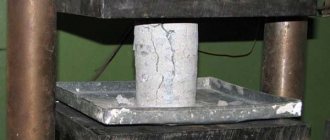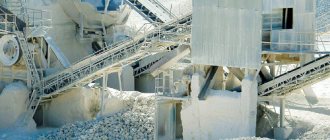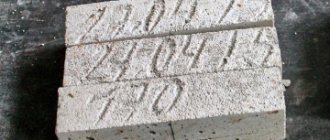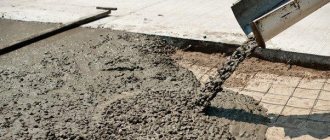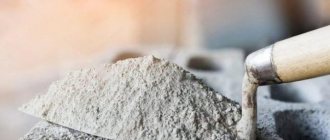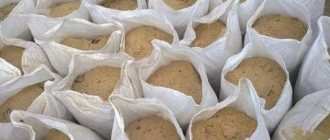INTERSTATE STANDARD
Cements
METHODS FOR DETERMINING NORMAL
DENSITY, SETTING TIME GOST
AND UNIFORMITY OF CHANGES IN VOLUME 3JQ 3—76
Cements. Methods for determining standard consistency, times of setting and soundness
MKC 91.100.10 OKP 57 3000
Date of introduction 01/01/78
This standard applies to cements of all types and establishes test methods for determining the normal density, setting time of cement paste, as well as the uniformity of changes in the volume of cement.
1. DETERMINATION OF NORMAL THICKNESS OF CEMENT TEST
Vika device
1 - cylindrical metal rod; 2 — frame frame; 3 - locking device; 4 - pointer; 5 scale: b—pestle; 7—needle
Crap. 1
1.1. Equipment
Vicat device with needle and pestle.
Ring for Vika's device.
Mixer for preparing cement paste.
1.1.1. The Vicat device (Fig. 1) has a cylindrical metal rod 1 that moves freely in the frame of the frame 2. To secure the rod at the required height, a locking device 3 is used. The rod is equipped with a pointer 4 for counting its movement relative to the scale 5 attached to the frame. The scale has a division value of 1 mm.
When determining the normal density of the cement paste, a metal pestle cylinder 6 is inserted into the lower part of the rod.
When determining the setting time, the pestle is replaced with a needle 7.
The pestle should be made of stainless steel with a polished surface. The needle must be made of rigid stainless steel wire with a polished surface and must not be bent. The surface of the pestle and needle must be clean.
The mass of the moving part of the device is maintained by mutually rearranging the pestle and needle. Individual moving parts
Official publication Reproduction prohibited
© Standards Publishing House, 1976 © IPK Standards Publishing House, 2003
parts of the device are selected so that their total mass is within (300 + 2) g.
The dimensions of the needle and pestle must correspond to those indicated in the drawing. 2 and 3.
1.1.2. The ring for the Vicat device and the plate on which the ring is installed must be made of stainless steel, plastic or other material that does not absorb water. The shape and dimensions of the ring must correspond to those indicated in the drawing. 4.
1.1.3. The mixer for preparing cement paste must meet the requirements of the relevant technical specifications.
1.1.4. If there is no mechanized mixer in the laboratory, a spherical bowl (Fig. 5) made of stainless steel is used to prepare cement paste.
Working part of the needle Working part of the pestle
+i
5
A
Normal density and setting time of cement paste. Uniformity of volume change
To determine the setting time and the uniformity of volume changes, the cement is mixed with water, the amount of which is determined by a standardized indicator - the normal thickness of the cement paste.
This indicator (or W/C ratio) for different cements varies widely (from 22 to 32%). According to GOST 310-60, the normal density indicator must be determined using a Vicat device. Cements with a higher normal density have a slightly higher water requirement, which may affect a relative decrease in their construction and technical properties. The indicator of normal density has a broader meaning than just for determining the setting time and the uniformity of volume change. This indicator is interesting for analyzing the properties of cement and is associated with the technical properties of concrete, in particular, it affects the determination of the plasticity-rigidity index of mixtures. Long-term aging of clinkers when they are wetted by rain (snow) sharply reduces the normal thickness of the cement paste. The reasons causing different water requirements of cements are systematized. The combination of these factors affects changes in normal density to varying degrees. Let's consider how each of these reasons is reflected in this indicator and what is the reason for this change.
Mineralogical composition. Normal density is influenced by the mineral C3A, which has a high water requirement. Consequently, to obtain cement paste of the same plasticity from cements with different amounts of the C3A mineral, different amounts of water are required. An increase in normal density is an indirect indicator of the high content of the C3A mineral in cement. Cements with a high content of the C3A mineral cannot be used for some concrete and reinforced concrete structures and structures (for example, in a water environment that causes sulfate corrosion, with repeated alternating freezing and thawing, for stressed structures where the amount of concrete creep is limited, etc.). The normal density of cement is less affected by the presence of calcium silicates (minerals C3S and C2S).
Lack of gypsum in cement. The presence of the C3A mineral in cement makes it necessary to introduce gypsum, a regulator of setting times, when grinding clinker. In practice, there may be a case when, due to different gypsum contents, cement with a large amount of the C3A mineral will have a lower normal density. The above emphasizes the importance of both systematic laboratory quality control in cement production and control during construction in the absence of technical documentation for cement - a passport with information.
Fineness of grinding. An increase in the grinding fineness of cement is associated with a slight increase in the amount of mixing water. In some cases, when the fineness of grinding changes, the water demand for cement increases significantly, which is associated with the content of small grains in cement (smaller than a few micrometers), as well as the structural features of the clinker; When mixing cement, most of the C3A mineral located in the clinker grains is exposed. However, the fineness of grinding does not significantly affect the indicator of normal density. When crushing clinker on a construction site or effectively grinding cement at precast concrete factories, many small fractions below 5 microns appear, the mixing of which requires more water than large fractions of cement, and the normal density becomes much higher. This should be taken into account when organizing work, for example, avoid excessive grinding of cement, which increases water demand, or use the most effective molding and compaction methods to compact mixtures. It should be borne in mind that such finely ground cements are classified as fast-hardening cements, and if they contain an increased amount of the C3S mineral, they are classified as high-strength (high-quality).
Cement staleness. The surface of cement grains is polymineral, which is why it is subject to varying degrees of change under the influence of the air environment. Almost all cements leave grinding units (mills) at high temperatures; corrosion products form on the surface of the grains in the form of a very thin layer of new formations. The formation of such a layer is associated with the presence of CO2 and water vapor in the air. Studies have shown that after preparation, cement should be stored for a minimum period of time and its quality depends on the conditions in which it is stored. Caking - loss of cement quality occurs more actively at high relative air humidity (on the banks of large bodies of water, during the rainy season). For this reason, to protect the cement from caking, the surface of the grains is covered with an organic film. To partially restore the quality of stale cement, additional grinding is needed, during which the grains are cleared of the layer of new growths and cracked onto new surfaces. Stale cement has an increased water requirement due to the formation of aggregates (floccules) from grains in it, the surface of which is bound by the reaction products of cement minerals with water.
Cases of improper storage of cement aggravate what has been said about a decrease in the quality of cement - they increase the caking of cement.
Availability of hydraulic additives. Hydraulic additives have different origins, which affects their water-holding capacity. Depending on the type and amount of hydraulic additive, the normal density of cement changes. For example, tripoli, which has a high molecular moisture capacity, increases normal density. Hydraulic additives, loose products of igneous rocks, as well as ground sand, reduce the normal density; loose varieties of carbonate rocks (limestones and dolomitized limestones), absorbing water, increase the water requirement of cement paste.
Presence of finely ground granulated blast furnace slag. This artificially produced hydraulic additive, by its nature, reduces the normal density of cement, which significantly improves the construction and technical properties of Portland slag cement and makes it possible to obtain concrete (mortar) mixtures of a given plasticity-rigidity with a lower water content.
Presence of surfactants. Significant correction of a number of natural deficiencies of Portland cement is achieved by introducing certain types of surfactants. The highest results are achieved by introducing a complex hydrophilic-hydrophobic additive into the cement, which simultaneously ensures high elasticity and hydrophobicity of the cement paste, i.e., contributes to the production of cement paste with a minimum amount of mixing water for a given plasticity-rigidity. It should be remembered that an excess amount of surfactants inhibits the chemical processes occurring between the minerals of cement grains and water. In some cases, with a significant excess of surfactants, the hardening process can be delayed for many years, which can cause defects in work. For this reason, for each surfactant there are optimal doses of cement additives.
The listed reasons for changes in the normal density of cement are the most significant and must be taken into account in practical work. In one case, they can contribute to a decrease in the normal density and, consequently, an increase in the construction and technical properties of cement; in the other, a decrease in normal density, achieved through a combination of another group of reasons, will not have the same effect as in the first case. Indeed, the indicator of normal density cannot be considered uniquely related to the quality of the cement stone formed after hardening of the cement paste. This or that effect is the result of a physical and chemical process occurring in a suspension of cement paste at the interface between the liquid (water) and solid phases (the surface of cement grains). In some cases, these processes go faster, in others slower, which is reflected in changes in the normal density indicator. From this information we can conclude that by changing the amount of mixing water it is impossible to accelerate the chemical process of binding water, which depends on: the nature of the cement, its fineness of grinding (dispersity), the chemical composition of the mixing water and the temperature of the process.
Pages:
- |
- |
- |
- |
- |
- |
- |
- |
- |
- |
- |
- |
- |
- |
- |
- |
- |
- |
- |
- |
- |
- |
- |
- |
- |
- |
- |
- |
- |
- |
- |
- |
- |
- |
- |
- |
- |
- |
- |
- |
- |
- |
- |
- |
- |
- |
- |
- |
- |
- |
- |
- |
- |
- |
- |
- |
- |
- |
- |
- |
- |
- |
- |
- |
- |
- |
- |
- |
- |
- |
- |
